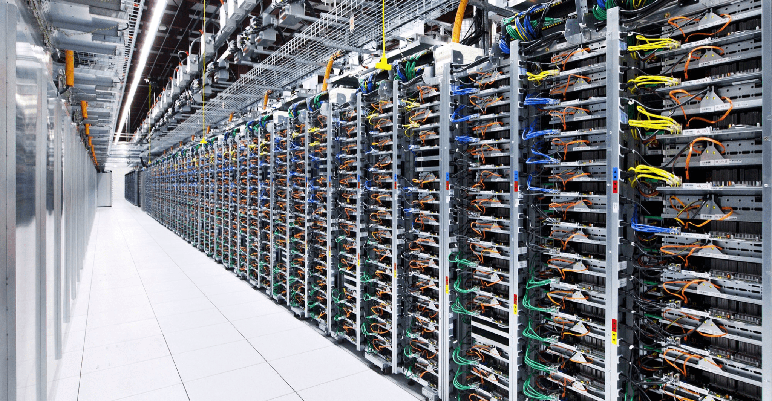Best Practices for Data Center HVAC Usage and Maintenance
With the average data center in and around Chicago using more than 100-times the energy of any other similarly-sized commercial facility, energy efficiency is understandably of keen interest to local companies in numerous industries. These buildings, dedicated to housing network servers and supporting equipment, are the hub for billions of increasingly vital online interactions and data storage that’s become essential to day-to-day life throughout our region.
At these mission critical sites, downsizing is rarely a viable strategy and downtime is simply not an option. Rather, the trend is for existing data centers to continually grow to meet demand, and for new data centers to spring up regularly as that demand keeps rising.

Why data centers must focus on energy efficiency
Digital technology has evolved incredibly fast in the last few decades and the modern world is so interconnected (between computers, mobile devices, Smart buildings, cloud-based apps, and more), there’s barely any aspect of our lives that is not directly impacted. This isn’t science fiction, it’s reality. And that reality demands quality data centers.
But, as noted above, running a data center is energy intensive. That’s challenging from both a cost perspective and when considering environmental impact. By optimizing a data center’s energy efficiency, companies have been able to balance significant cost savings and ecological benefits while still meeting their customers’ ever-growing needs.
The unique challenges and opportunities in data center HVAC
There are many options for improving energy efficiency in a data center, including:
- Type, size, and configuration of stacks
- Power supplies
- Cables
- Ventilation and cooling installation and operation
In this article, we’re focusing on best practices for the installation and maintenance of energy efficient HVAC equipment for data centers.
Air management
One of the keys to data center HVAC efficiency is setting up what’s called a hot aisle/cold aisle configuration for air exchange within the server and storage stacks.
In its simplest form, a hot aisle/cold aisle configuration involves arranging servers on their racks — and racks in relation to each other — so exhaust vents all blow hot air into the same central aisle and cooling fans all draw from a separate aisle. These aisles are isolated from each other so air doesn’t mix, and ventilation is situated to draw in cool air and expel hot air efficiently.
This simple practice can as much as double the cooling capacity of the data center’s entire HVAC system. According to Pacific Gas and Electric Company (PG&E), this one efficiency best practice “can reduce data center cooling costs by over 60% (when combined with an air-side economizer).”
It sounds like common sense — and it really is — but many older data centers were not originally designed this way, and there are often sections of the building where heat exhaust routinely mixes with cooled air. This could harm the equipment, and it definitely forces the cooling system to work much harder to maintain optimal conditions.
With a hot aisle/cold aisle configuration in place, the facility will require a smaller cooling system, and it will need to run less often. This translates directly to lower operating costs and a longer life span for the equipment.
On the other hand, poor air management can cut a cooling system’s capacity and efficiency in half. Often, poor air management can be traced to common, resolvable issues in the building’s design:
- Leaking floor tiles
- Leaking cable openings
- Poorly placed overhead supply vents
- Plenum obstructions under the floor
- Poorly placed rack exhausts
Air-side economizer
A valuable addition to any data center’s HVAC system is an air-side economizer.
An air-side economizer offers an efficient method of switching between air conditioning and pulling in cool air from outside the building. Data center air also needs to be effectively filtered and at the right humidity level for the highly sensitive equipment, so these factors need to be covered when utilizing outside air. But, outside air can be cleaned and humidified for far less energy than it takes to artificially cool the air.
This results in tremendous energy savings.
Efficient control systems
Finally, the addition of modern digital control systems can enhance the value of the two best practices described above, essentially setting the system on autopilot. Modern controls can be easily automated, monitored, and optimized minute-by-minute, amplifying the cost-savings dramatically. By adding machine learning AI to the mix, a fully automated control system can bring data center energy efficiency to a brand new level.
For example, powerful controls can make the decision to switch off the air conditioning and switch on the air-side economizer automatically, the moment the system’s sensors note that the outside air is cool enough to do so. Or, they can distinguish a temporary and/or localized temperature spike (such as a single rack component overheating or working harder,) from a need to lower the building’s temperature across the board. The control system can make the most efficient use of quality equipment like variable speed fans and zone cooling to handle changing needs without wasting energy.
The latest digital control systems also include intelligent analytics software that lets you analyze the system’s energy usage data and pinpoint additional ways to fine-tune a data center’s energy efficiency.
These three best practices are just the start. Modern technology has made optimizing the energy usage of a data center easier than ever. We’re proud to specialize in data center HVAC installation, design, and maintenance at Midwest Mechanical, and we’d love the opportunity to discuss any HVAC needs Chicago’s data centers may have. We can help you determine where improvements can be made.

